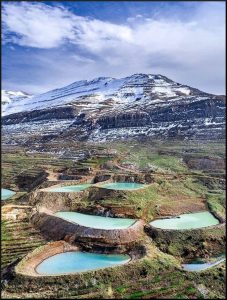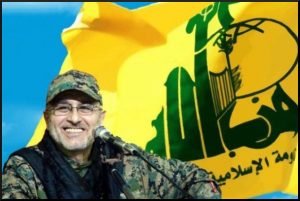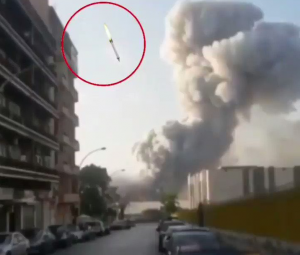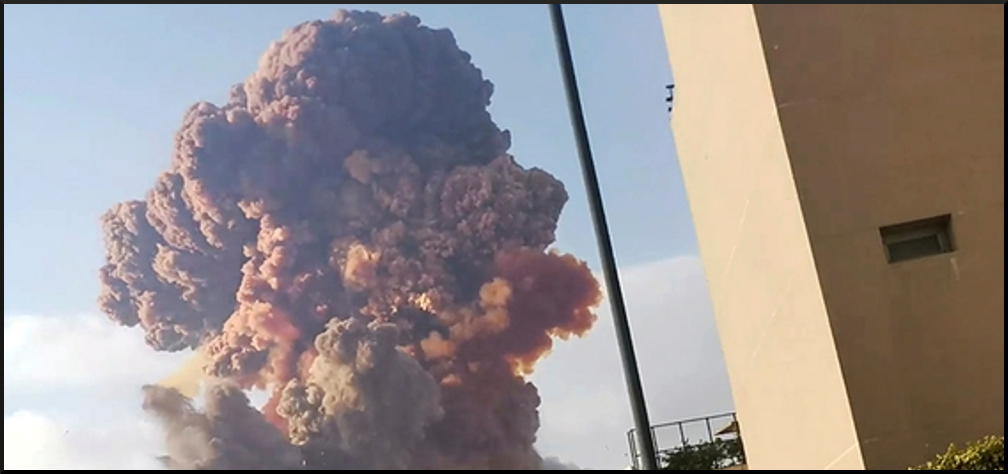by Jeremy Salt, published on the American Herald Tribune, August 11, 2020
In the old days there was no more charming city in the eastern Mediterranean than Beirut. Set on a maritime plain with the mountains rising dramatically behind it, the scenery was magnificent, the culture charming, the people hospitable and the city rich in history.
Unfortunately, however, Lebanon’s prime geographical position sucked the country and its capital into the vortex of regional and international politics from the 19th century onwards. Sectarianism and the inability of the people to put the interests of their country ahead of their faith dragged it further down. There was no more potent weapon in the armory of scheming outside powers than this massive fault line running through Lebanese society.
Seizing Syria after the First World War, Britain and France chopped it up. Britain gave Palestine – southern Syria – to the Zionists. France kept the rest. In 1918 it occupied Beirut, with the support of the Maronite Christians and against the opposition of the Muslims. Moving across the mountains, it occupied Damascus after defeating a Syrian national force at Khan Maysalun, in the anti-Lebanon mountains about 25 kilometers from Damascus, in July 1920.

In October 1920 France separated Mt Lebanon and the maritime plain from the Syrian hinterland to create the republic of Grand Liban. Its strategic object was to cut a large segment of Syria’s Christians, the Maronites, off from the Syrian hinterland (which it then proceeded to divide even further along sectarian lines). Historically aligned culturally with France and the ‘west,’ the Maronites were hostile to what they saw as a Sunni Muslim-inflected Arab nationalism. In what they perceived as their own interests, they could be counted on to further French interests in the Near East.
Their sympathy for zionism reached the point in May, 1946, when the Maronite Patriarch, Antoine Arida, signed a ‘treaty’ with the Jewish Agency in which he acknowledged all core zionist claims, including the allegedly historical link with Palestine, the ‘right’ to open immigration “and independence” in a Jewish state. This ‘treaty’ was no more than the patriarch’s personal initiative, but it did represent broad Maronite identification with Zionism as an equally vulnerable minority presence in the Middle East.
As established under French supervision, the 1926 constitution describes Lebanon as “Arab in its identity and affiliation.” Elections to the Chamber of Deputies were to be held on a “national non-confessional basis” but at the same time – more than somewhat contradictorily – there was to be equal representation of Muslims and Christians in Parliament and proportional representation of the confessional groups within the two broader Muslim and Christian communities. The president was to be elected on the basis of two-thirds majority support in the Chamber.
In 1943 with Vichy France defeated in Syria and with Lebanon looking ahead to the end of the mandate, its Muslim (Sunni and Shia) and Christian leaders met to discuss what next. President Bishara al Khuri and Prime Minister Riad al Sulh fashioned the ‘national pact’ which has underpinned Lebanon’s ‘confessional democracy’ ever since. Broadly, Lebanon would remain only “affiliated” to the Arab world (rather than part of it) in return for a Christian pledge not to seek support from the ‘west.’
In its executive and parliamentary makeup, the president of the republic would always be a Maronite, the Prime Minister a Sunni Muslim, the speaker of the Chamber of Deputies a Shia Muslim, the deputy Prime Minister and deputy speaker of the Chamber a Greek Orthodox and the army chief of staff a Druze. Parliament would be elected on the basis of a 6-5 Christian-Muslim majority, this sectarian allocation of power applying across all state institutions.
Even by the 1930s it was doubtful that Lebanon had a Christian majority. It is for this reason that a census had not been held since. The Maronites would certainly not want to be confronted with the statistical proof of their shrunken minority status. On the available evidence now a census would show that the population is about 60 per cent Muslim, about evenly divided between Sunni and Shia. Of the 36 per cent of the Christian population, the Maronites account for perhaps 21 per cent. Talk of ‘Christian Lebanon’ is obviously misleading when the buk of the population is Muslim. Not only that, there is no consolidated Christian view, politically or religiously. Each confessional group has its own liturgies and political interests. The Maronites also have a long history of fighting savagely among themselves.
No Lebanese wanting to live in a proper democracy could possibly support the ‘confessional’ formula but with some modifications it has prevailed to the present day. It is the seedbed of all Lebanon’s problems. It has engendered corruption, endless feudal bargaining between the zaims – the sectarian political leaders – and it has kept Lebanon permanently open to meddling from outside.
Under British pressure the French finally withdrew from Lebanon in 1946. Lebanon’s first civil war had been fought in 1860s and the second was soon to come. In 1958 President Camille Chamoun abrogated the national pact by calling for western intervention to suppress the rising tide of support in Lebanon for Egypt’s President Gamal abd al Nasir. US marines landed on Beirut’s beaches from the Sixth Fleet but on this occasion the zaims managed to settle their differences themselves.
The third civil war followed in 1975 and lasted until 1989. Although sectarian affiliations would decide who died and who lived, the trigger for this conflict was the Palestine question. Driven out of their country in 1948, Palestinians flooded into Jordan, Syria and Lebanon, whose rickety social and political fabric could not withstand the pressure of this extra burden and finally collapsed.
Outside intervention in 1976 by Syria (at the request of the Arab League) and interference by the US and Israel turned Lebanon yet again into the epicentre of a regional and international power struggle. Tens of thousands of Lebanese died, with Israel’s invasion of 1982 alone ending the lives of about 20,000 people.
Succeeding in driving out the PLO, the Israeli invasion was the catalyst for the rise of a far more dangerous enemy, Hizbullah. By 2000 it had driven Israel out of southern Lebanon by standing firm in the war of 2006, so that zionist ground forces were unable to capture villages even a few kilometres from the armistice line, it again imposed humiliation on the enemy. Since then many of Israel’s senior political and military figures have warned that in the next round they will destroy Lebanon entirely, driving it back to the Stone Age or the Middle Ages, as they say. This is their ‘Dahiyya strategy,’ named after their widespread aerial destruction in 2006 of a largely Shia southern Beirut suburb of that name.
Spying for Israel
There is a chilling parallel between the port explosion and an event not nearly so destructive in damage and loss of life but the equivalent in its impact on Lebanon’s Lebanese social and political structure. This of course is the assassination of former Prime Minister Rafiq Hariri in February, 2005. Because of his sometimes difficult relationship with the Syrian government, it was Syria that was immediately blamed by Hariri’s son Saad, by Maronite Christian political factions and by ‘western’ governments. Syria was driven into a corner and forced to withdraw its remaining troops from Lebanon. They were few in number and stationed well away from the capital but the government in Damascus was humiliated internationally.
Four ‘pro-Syrian’ Lebanese army generals were arrested on August 30, 2005, and held in custody by the government for four years without being charged before being handed over to the UN-appointed Special Tribunal for Lebanon, which immediately released them for lack of evidence. The tribunal was established in 2009 on the basis of an agreement between the UN and the government of Lebanon but was never ratified by Lebanon’s Chamber of Deputies
In 2010 Hariri’s son, Saad, Prime Minister since November, 2009, admitted that he was wrong in accusing Syria: the charge had been “politically motivated” and the tribunal misled by false testimony against the four generals. Without apologizing or explaining how it came to be deceived, the tribunal proceeded in 2011 to lay charges of conspiracy to murder against four men linked with Hizbullah, Mustafa Amine Badreddine, Salim Jamil Ayyash, Hussein Hassan Oneissi and Assad Hasan Sabra.

Badreddine was a cousin of Imad Mughniyah, a senior Hizbullah figure assassinated by Israel in Damascus in 2008. Badreddine himself was killed by an explosion near Damascus airport in 2016 but by that time another name had been added to the Special Tribunal’s list of accused, Hassan Habib Merhi, charged in 2012. These suspects are all being tried in absentia. Hasan Nasrallah says the charges are a politically motivated fabrication and that wherever they are, the men will never be handed over by Hizbullah.
The first important point to be made about the Special Tribunal is that it never canvassed the range of possible suspects. Against their record of extreme violence in Lebanon, the US and Israel would have to be high on the list of suspects but they were not even considered. The tribunal went straight for Syria and when that collapsed it went straight for Hizbullah.
On October 27, 2010, three of its agents went to Dr Iman Charara’s obstetrics clinic in Dahiyya, apparently with her prior approval but not with Hizbullah’s. Given the destruction of Dahiyya by Israel in 2006, this was understandable: Hizbullah had to be watchful about who was coming and going in the suburb. At the clinic the agents demanded the phone numbers and addresses of 17 patients dating back to 2003. They would all be the female relatives of Hizbullah members, but whoever they were, Dr Charara would have been violating doctor-patient confidentiality by surrendering this personal information.
Inside the clinic women waiting for their consultation physically attacked the three agents, calling them Israelis and Americans and seizing a computer, notebooks, a cell phone and other material, all later returned. (According to one account, largely based on the sight of a large hand, some of the women were actually men.)
The Special Tribunal made other extreme demands. It demanded and was apparently given access to the data base of all students at private universities from 2003-2006 but was blocked when it sought the fingerprints and passport details of all Lebanese along with all telephone and DNA records.
The second important point to be made about the tribunal is that its evidence is circumstantial and heavily based on totally compromised mobile phone calls. By the time of Hariri’s assassination, Israel had long since penetrated Lebanon’s two main telecommunications providers, with agents inside providing it with data that allowed it not just to monitor phone calls but to fabricate them.
In 2010, 50 employes of the Alfa state telecommunications company were arrested and charged with spying for Israel. They included two senior technical figures, Charbel Qazzi and Tariq Raba’a. In his confession Qazzi said he had first been contacted by Mossad in the 1990s. He had access to all passwords needed to enter mobile network computer systems remotely or online. These he had handed to Israel.
Raba’a was recruited by Mossad in 2001. He gave Israel full details of Lebanon’s mobile network plus the names of all Alfa employes. Israel’s infiltration included the tampering with BTS (base transceiver station) towers either physically or remotely and the use of a firewall manufactured by Israeli companies allowing Israel to install backdoors and give it access for remote logins.
A retired general who had spied for Israel from 1994-2009 provided Israel with Lebanese sim cards. In 2009 Hizbullah and Lebanese security exposed three Hizbullah members who had been spying for Israel. Their phones has been installed with a software program allowing a second line to be linked to their phones and a third person to access all their data. This ‘twinning’ on one sim card turned on when the phone was on and off when the phone was turned off.
Israel’s infiltration of the Lebanese telecommunications sector was so extensive that none of the calls allegedly connecting suspects to Hariri’s assassation can be regarded as authentic without the absolutely incontrovertible proof that the tribunal is unlikely to have. According to Hasan Nasrallah, Israel had gained complete control over Lebanon’s telecommunications network.
In August 2010, not long after the arrest of the Alfa spies, Nasrallah made an announcement he said he did not want to make because it would reveal how extensively Hizbullah had penetrated Israel’s electronic communications and drone surveillance. He said that for three months before his assassination (February 14, 2005), an Israeli drone had been shadowing Hariri, from his home in Beirut to the government offices, and from his home in the city to his home in the mountains. It had followed him along the corniche road on the day of his assassination.
According to Nasrallah, an Israeli AWACS plane was overhead and an Israeli agent on the ground when Hariri’s convoy was destroyed and the former Prime Minister and 21 others killed and hundreds injured. This evidence of possible Israeli involvement in the assassination was handed to the Special Tribunal by HIzbullah but apparently taken no further.
‘Hizbullah, Hizbullah, Hizbullah ..’
The trail to the destruction of Beirut’s port began in Batumi, Georgia, in September, 2013 when a Russian-owned ship, the MV Rhosus, set off for Mozambique loaded with 2750 tonnes of ammonium nitrate. The boat was owned by Igor Grechuskin, a ‘businessman’ in his early 40s, now living in Cyprus and last seen when photographed straddling a gleaming motorbike.
The Rhosus made it to Tuzla in Turkey and then Volos in Greece for refuelling. After the crew could not be paid because the owner had run out of money the boat headed to Beirut to pick up additional cargo that could be sold in Aqaba. However, the excavators and roadmaking machinery stacked on deck were so heavy that the doors to the cargo hold buckled. In addition, there was no money to pay port fees and the Russian and Ukrainian crew had filed legal complaints over conditions and non-payment of salary. The ship also had a leak in the hull when it reached Beirut. The crew had been regularly pumping water out to keep it afoat.
Judged unsafe to sail and in breach of port and maritime regulations the Rhosus was allowed to go no further. By November 2014 the ammonium nitrate had been unloaded and stored in hangar 12. The crew was confined to the boat for 11 months before being released. Abandoned by its owner, the Rhosus sank close to the port’s breakwater in February, 2018.
There have been several spectacular explosions of ammonium nitrate in the 20th century. In 1921, at Oppau in Germany, a 4500-tonne mixture of ammonium sulfate and ammonium nitrate fertilizer exploded, killing 500-600 people. In 1947, fire on board a French freighter in the port of Texas City, Galveston Bay, ignited 2300 tonnes of ammonium nitrate, the explosion killing nearly 600 people.
The Beirut port explosion was one of the biggest in history outside the detonation of a nuclear bomb. The immediate port district was leveled, with the shock wave surging into the fashionable Gemmayzeh district and destroying or damaging apartment blocks and shops, restaurants and the clubs that were the centre of night life. The damage included the silos adjacent to the port where 80 per cent of Lebanon’s grain supplies were stored, leaving it with only enough to last a few weeks.
Negligence was obviously involved. The port customs authorities were aware of the danger and had made six requests between 2014-2017 for the ammonium nitrate to be be shifted but nothing was done.
The political finger-pointing started immediately. The Maronite Patriarch, Bechara Boutros al Rai, seized the opportunity to berate Hizbullah. Baha Hariri, one of Rafiq Hariri’s sons, claimed that “everyone in the city knows” that Hizbullah controlled the port. It was said to be storing arms and ammunitions which somehow triggered off the devastation on August 4. In fact, Hizbullah does not control the port and had no weaponry or ammunition stockpiled there.
In his reaction to the bombing, Nasrallah referred to Lebanese and Arab media commentators whose position had been decided in advance. In their view
“the cause of the explosion in hangar number so-and-so at the port of Beirut was a Hizbullah missile warehouse that exploded and caused this unprecedented terror and cataclysm. Or, they said, it was stockpiles of HIzbullah ammunition, explosives or weapons. The bottom line is that it must have belonged to Hizbullah, whether it was missiles, ammunition, or explosives … and even when the authorities announced that it was not missiles, weapons, ammunition, explosives or anything like that but (ammonium) nitrate used as a fertilizer or an explosive, these people said that this nitrate belonged to Hizbullah, that it was Hizbullah that brought it, that it was Hizbullah that stored it for six years and again, Hizbullah, Hizbullah, Hizbullah …”
Fury swept the streets in the aftermath of the explosion. Demonstrators broke into government ministries in various parts of the city, cabinet ministers and members of parliament resigned until the government of Prime Minister Hasan Diab finally fell, Diab saying that corruption was systemic and larger than the state.
The ‘west’ had already plunged into the crisis. President Macron immediately flew to Beirut, offering aid. Speaking like a French High Commissioner during the 1930s, he took it upon himself to call for a new political order and demand that Hizbullah stop serving the interests of another government. The US called for ‘peaceful’ regime change. At the same time, both Trump and Defence Secretary Mark Esper raised the possibility that the explosion had been the result of a deliberate attack.
President Michel Aoun called for some clear answers within a few days but like the Hariri assassination, clear answers to what exactly happened at the port of Beirut on August 4 may never be forthcoming.
 Apparently (or clearly) photoshopped images of a missile about to strike the port soon filled the social media. Other material was more persuasive, with one video showing men walking along the street and pointing at something in the sky seconds before the shock wave hit them. Another clip shows a group of young women stopping to look up at the sky after apparently hearing something. Nasser Yassin, a professor at the American University of Beirut, described hearing a sound like a jet aircraft or a missile flying overhead a few seconds before the explosion … “we’re like 35 or 40 kilometers from Beirut, overlooking Beirut, and we heard this very clear.”
Apparently (or clearly) photoshopped images of a missile about to strike the port soon filled the social media. Other material was more persuasive, with one video showing men walking along the street and pointing at something in the sky seconds before the shock wave hit them. Another clip shows a group of young women stopping to look up at the sky after apparently hearing something. Nasser Yassin, a professor at the American University of Beirut, described hearing a sound like a jet aircraft or a missile flying overhead a few seconds before the explosion … “we’re like 35 or 40 kilometers from Beirut, overlooking Beirut, and we heard this very clear.”
The general context is not complete without referring to the pending decision of the Special Tribunal. Due on August 7 it will be issued on the morning of August 18. Furthermore, in the week before the explosion tension had also been rising on the Israel-Lebanon 1949 armistice line, with Hizbullah denying an Israeli claim that it had launched an attack in the occupied Shaba’a farm zone following the killing of a Hizbullah fighter in Syria.
The ‘floating bomb’
The clear answer as to who benefits from the Beirut port explosion and the instability which has followed is Israel. Israel has periodically devastated Lebanon, killing tens of thousands of people. Its aircraft and drones routinely violate Lebanese air space, frequently launching missiles into Syria from Lebanon. It has run rings of spies in Lebanon for decades and has the entire country under surveillance from satellites, from human intelligence and from spying devices seeded from north to south. It badly wants Hızbullah destroyed and its political and military figues have repeatedly threatened Lebanon with an attack that will dwarf the destruction wrought in 2006. The port explosion has broken the government and put Hizbullah under extreme pressure domestically and from the outside.
A further consideration is that Beirut was always seen in Israel as a rival financial and business centre to Tel Aviv in the eastern Mediterranean. Decades of instability created by civil war, Israel’s repeated attacks and interference in its political and financial affairs by outside governments have wrecked the position the city held in the 1960s as a financial hub for the entire Middle East. Economic crisis – partly brought on by ‘western’ sanctions directed against Hizbullah – followed by the explosion in the port leave behind only the shards of this reputation.
Could Israel have arranged the destruction of the port? Given its long experience of causing chaos across the Middle East, the answer is obviously ‘yes.’ The ammonium nitrate was a floating bomb taken to Beirut and stored in a warehouse for six years. It only needed someone to light the fuse. Compared to the intricacy of other Israeli operations, this would surely be a comparatively simple matter.
So Israel could have done it, but would it have done it? Certainly, on the basis of its merciless destruction of Lebanon in the past, not to speak of its frequent devastation of Gaza, it would not have been impeded by moral considerations. Was it in any way responsible, or was the explosion wholly the outcome of utterly criminal negligence? An inquiry, international or Lebanese, may never be able to satisfactorily answer these questions.
Lebanon remains trapped in the mire of 1943. It is not a change of government that is needed but a change of the system and a change in the mentality of the Lebanese people so that they uniformly put their country ahead of sectarian loyalties. The old system needs to be torn up by the roots. Otherwise this blood-soaked cycle is never going to end. Lebanon will remain forever exposed to sectarian division stoked by regional and global powers in their own interests.
This cycle of disasters has been going on in Lebanon since the 19th century. It is part of ‘the game of nations’ as described by CIA agent Miles Copeland in his 1969 book of the same name, a ‘game’ in which the kings, presidents, prime ministers, army chiefs, entire countries and ordinary citizens across the Middle East are ultimately no more than expendable pawns on the board.
Jeremy Salt has taught at the University of Melbourne, Bosporus University (Istanbul) and Bilkent University (Ankara), specialising in the modern history of the Middle East. His most recent book is “The Unmaking of the Middle East. A History of Western Disorder in Arab Lands” (Berkeley: University of California Press, 2008.)
